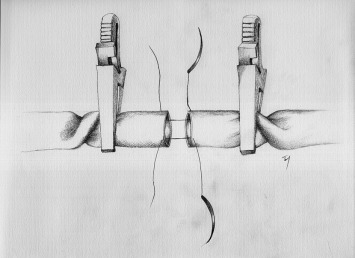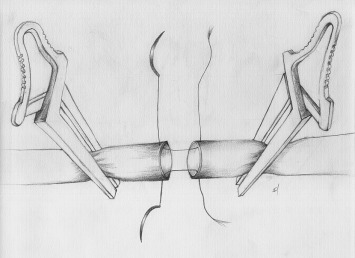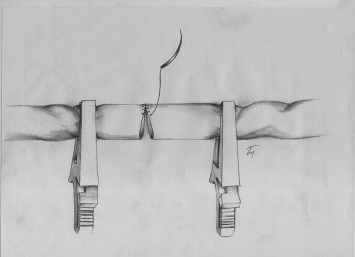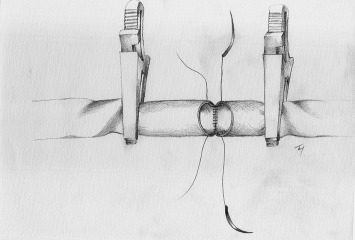Summary
Background/Objectives
Back wall technique is usually used for hepatic artery anastomosis in living donor liver-transplantation. In this technique, two stitches are placed in the two corners of the artery wall initially and the microclamp on the artery is rotated to place the sutures to the back wall first. In some cases, the microclamp cannot be rotated because of insufficient length of the graft or recipient artery. If this occurs, it may be difficult to rotate the artery to perform the back wall artery anastomosis technique. In these cases, the difficulty of performing the anastomosis can cause intimal tears. Thus, we prefer a modified technique for artery anastomosis in such situations.
Methods
In this modified technique, two stitches are placed in the middle of the posterior wall and middle of the anterior wall initially. The artery is twisted 90° to the right side and to the left side respectively, instead of one 180° rotation, to place the back wall stitches.
Conclusion
In this modified technique, reversing the microclamp is eliminated that can cause intimal damage. Therefore, it may be superior to the conventional method in terms of reducing the difficulty of performing anastomosis and intimal damage to the vessels.
Keywords
back wall technique;liver transplantation
1. Introduction
Hepatic artery (HA) anastomosis is still a challenge in living donor liver-transplantation (LDLT) because of the technical difficulties related to the deep location of the artery in the abdominal cavity, small diameters, and insufficient length of the vessels.1 In the conventional method of microvascular anastomosis, the arteries are held with microclamps with two corner sutures, and are rotated 180° for posterior wall anastomosis.2 A back wall first anastomosis technique has significant advantages for HA reconstrunction if the length of the arteries are sufficient. But especially in LDLT, if the graft artery has an insufficient length to reverse the microclamp it is difficult to use the conventional twist technique. If this occurs, it is difficult to place the sutures in the posterior wall and it may result with the intimal damage of the artery.
To accomplish the HA reconstruction easily and safely, we modified the technique in which two stitches are placed in the middle of the posterior wall and the middle of the anterior wall initially, instead of corners and arteries, and are twisted 90° instead of 180°.
2. Methods
Between 2009 and 2014, we performed 29 LDLTs in the transplantation unit of Gaziantep University. Ages ranged from 6 years to 65 years, and the men/women ratio was 18/11. Their mean age was 50.1 years. We used the conventional twist technique if the length of the vessel was sufficient. For 28 patients we used right liver graft and for one patient we used the left lateral segment graft. The right HA was used for anastomosis in all cases recipients, except for one. When it was difficult to turn over the graft artery because of shortness, we used the modified technique.
In four patients the graft artery was short. One of these patients was operated on before using this modified technique, and the artery was reconstructed with the conventional technique. In three patients we used the modified technique.
2.1. Surgical technique
For the recipients, the right and left HAs were dissected high in the portal hepatis to maximize the arterial length and the reconstruction flexibility. The graft HA was always examined and the appropriate size matched recipient artery was used for anastomosis in an end-to-end manner.
In the conventional twisting technique, vascular clamps were used horizontally from the right to the left corner with two stay sutures. A stay suture was placed on the right corner (9 o'clock position) and the other was placed on the left corner (3 o'clock position) of the wall of both recipient and donor arteries. The microclamps were rotated 180° to place the back wall stiches first (Figure 1).
|
|
|
Figure 1. The conventional twisting technique. |
In the modified technique, the vascular clamps were put vertically. Because of the difficulty in holding the clamps steadily, the clamps were twisted 90° to the right side first before the placement of the stiches. By twisting the clamps 90°, the middle of the posterior wall (6 o'clock position) comes to the left corner and the middle of the anterior wall (12 o'clock position) to the right corner (Figure 2). Two stitches were placed in the right and left corners first. The artery is twisted 90° to the right side and to the left side respectively instead of one 180° rotation to place the back wall stitches (Figure 3 ; Figure 4).
|
|
|
Figure 2. Placing two stitches to the middle of the posterior wall (6 o'clock position) and middle of the anterior wall (12 o'clock position) in the modified technique. |
|
|
|
Figure 3. The artery is twisted 90° to the right side. |
|
|
|
Figure 4. The artery is twisted 90° to the left side instead of 180° rotation once to place the back wall stitches. |
In all patients, the arterial reconstruction was performed with interrupted sutures using 8-0 prolene sutures and a 3.5× magnification loupe. Immediately after the HA reconstruction, the patency of HA is checked using color Doppler ultrasonography. This examination was performed once a day for 10 days after surgery.
3. Results
The total incidence of hepatic artery thrombosis (HAT) was 3.4% (1/29). In four patients, the graft artery was short. One of these patients was operated on before using this modified technique and the artery was reconstructed with the conventional technique. HAT occurred in this patient on postoperative Day 5 and we lost the patient due to sepsis. There was no case of HAT in patients that were reconstructed with the modified technique.
4. Discussion
LDLT reconstruction of the HA is challenging because of many technical difficulties. One of the most important technical difficulties is related to insufficient length of the HA. In some anatomical variations of HA, the segment-4 artery arises from the right HA. In this condition, preserving the segment-4 artery may result in short graft HA. Also, the right HA may be short in some grafts without anatomical variation. It is dangerous to use the conventional twist technique in short arteries. In some cases, a microclamp cannot be rotated because of the insufficient length of the graft or recipient artery. If this occurs, it may be difficult to rotate the artery to perform the back wall artery anastomosis technique. In these cases the difficulty of performing the anastomosis can cause intimal tears.
To overcome this problem, many authors have reported various solutions. Yamamato et al3 reported a back wall first suturing technique without turning over the clamp in LDLT. Particularly in short arteries, it is also not easy to perform the posterior wall first suturing without turning over the microclamp. Okazaki et al4 reported posterior wall repair first with double needle using each suture from the inner side of the arterial wall to the outer side. In this technique, to tie the stiches at the posterior wall and in the deep field is not easy. Some authors reported continuous suturing to overcome the difficulties of reconstruction in short HA.1 ; 5 The extended dissection of the HA to the hilum may be another solution in short arteries. But it will not be possible in all cases. Also, extended dissection may cause intimal tears or may damage the vascularization of the biliary ducts.
The reason behind intimal tears and technical difficulties of the conventional twisting technique in short arteries is the 180° rotation of clamps to place the back wall stiches first. Our modified suturing technique does not require that the arteries be turned over 180°, which allows the posterior wall to be done first. The artery is twisted 90° to the right side and to the left side respectively, instead of a 180° rotation. In the short arteries used in our series, with the conventional twisting technique we had one HAT, but it was easier to perform in our modified technique and the patients are doing well without incidence of HAT. Especially in short arteries, to get the advantages of the interrupted suturing and to prevent the risks of twisting the artery, our technique is easy and feasible.
In this modified technique, reversing the microclamp is eliminated that can cause intimal damage; therefore, it may be superior to the conventional method in terms of reducing the difficulty in performing the anastomosis and intimal damage to the vessels. However, its advantages should be validated by further controlled studies.
References
- 1 M. Okochi, K. Ueda, T. Hirose, et al.; A modified technique for hepatic artery reconstruction in living donor liver transplantation; Microsurgery, 30 (2010), pp. 541–544
- 2 G.D. Harris, F. Finseth, H.J. Buncke; Posterior-wall-first microvascular anastomotic technique; Br J Plast Surg, 34 (1981), pp. 47–49
- 3 Y. Yamamoto, T. Sugihara, S. Sasaki, et al.; Microsurgical reconstruction of the hepatic and superior mesenteric arteries using a back wall technique; J Reconstr Microsurg, 15 (1999), pp. 321–325
- 4 M. Okazaki, H. Asato, A. Takushima, et al.; Hepatic artery reconstruction with double-needle microsuture in living-donor liver transplantation; Liver Transpl, 12 (2006), pp. 46–50
- 5 A.C. Tannuri, R.F. Monteiro, M.M. Santos, H.T. Miyatani, U. Tannuri; A new simplified technique of arterial reconstruction in pediatric living-donor liver transplantation: a comparison with the classical technique; J Pediatr Surg, 49 (2014), pp. 1518–1521
Document information
Published on 26/05/17
Submitted on 26/05/17
Licence: Other
Share this document
Keywords
claim authorship
Are you one of the authors of this document?



